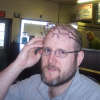I haven't had a chance to read this whole thread yet, but wanted to join in the fun. Vicki, just a little clarification. The reflex to breathe is determined by both blood gases mentioned. When O2 factors in as liam correctly stated, the "hypoxic ventilatory drive" is at play. When CO2 comes in to play the "hypercapnic ventilatory drive" is triggered. Some patients' respiratory drives are thought to be primarily hypoxic while others are thought to be primarily hypercapnic.Vicki wrote:True Liam, my APAP is an older model ResMed Autoset T. But the sleep labs I've spoken with recently still aren't satisfied with APAPs. Just a little clarification, the reflex to breath is actually not a decrease in O2 sat., but a rise in CO2. A moot point since none of the autoPAPs measure either, but other responses like vibration, etc. Therefore, an apneic event has to be started for an APAP to recognize the need for increased pressure.
Vicki
"AutoPAPs requiring an apnea to prevent yet another apnea" is actually a myth. AutoPAPs can and will trigger on residual apneas to prevent subsequent obstructive events. However, snore in and of itself and even slight non-apneic flow limitation are used as precursor indicators toward determining proactive AutoPAP pressure response strategies. In addition, AutoPAPs tend to perform airway collapsibility tests using correlations between slight pressure deltas and patient air flow. All of these latter methods are proactive and none entail an apnea. Without them so many patients wouldn't be able to achieve their nighly AHI indices of under 1 or 2. The bottom line is if these proactive airway gauging techniques result in neither cortical arousal nor appreciable SpO2 drop, then there is no inherent physiological risk or problem. Any given AutoPAP algorithm will fall short for some patients---but so will fixed CPAP pressure leave more than just a few patients with unsatisfactory treatment (many of which are now happy AutoPAP patients on these message boards)!
Guest, Resmed has published the A10 algorithm as specifically holding a pressure response "command on apnea" at 10 cm or less to avoid what they term "runaway central apneas" (which specifically refer to pressure-induced occurences). The other AutoPAP manufacturer's also take great care (expressed in great detail in their patent descriptions) to avoid the pressure-induction of cental apneas as well. However, none of these manufacturers give us patient-based probabilities or statistics relative to the pressure induction of central apneas. Yet, if the rate was not significant across the SDB patient population, why would all of the manufacturers devote so much development cost and effort toward avoidance of pressure-induced central apneas?













